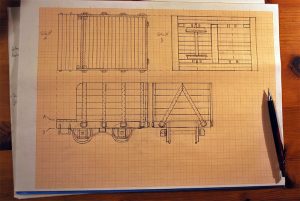After the basic requirements regarding the dimensions were cleared, an extensive online Image research took place. Apparently, opinions are divided whether a model Porter with a tender is a prototypical sight. Fortunately, I can avoid this topic altogether because I’m not going to model an explicit prototype. Instead, I’ll experiment with different themes and decide on a case-by-case basis whether and to what extend I’ll let the prototype reign supreme or just get some inspiration for my own creations.
On this occasion I’m shooting for a semi-freelance-model: My porter is going to be the first purchase of an aspiring industrial, who founded a shortline railway somewhere in the USA in the early 20th century and tried to bring it to fruitition. (Of course, I’ll eventually get more specific.)
At any rate, the small Porter just didn’t have the required operating range and there were no funds to raise a supply depot every few miles. Hence, the tender.

The tender was to be realized by a local vehicle builder as an inexpensive, sturdy custom-job. The model was to serve me as a testbed in order to get some experience in the construction of running gears, something I’ve never done before. Anyway, I was set to try out working axle bearings, if possible with suspension. The Running gear was supposed to be made of brass, to get stability and a low center of mass.
On the other hand, the frame and superstructure were to be made of wood, red cedar in this case for its weather-resistance and sturdiness, while being light-weighted at the same time. Where possible I wanted to build all parts myself from scratch. Exceptions were made for the wheelsets and couplers from the start because I don’t own neither a lathe nor a mill. It’s a good guess the list of exceptions might grow, but only future will tell.
The most important tools for this project were going to be my saws and files. Add my drill with stand and a small circular saw for cutting wood. The scroll saw will take care of cutting non-ferrous metal.
According to the blueprints, the tender was to be made from a short, two-axled gondola, with removable boards to access the fuel. The running gear was loosely inspired by typical narrow-gauged prototypes. The small details weren’t planned very far at this point, only steps and handle bars were intended.
